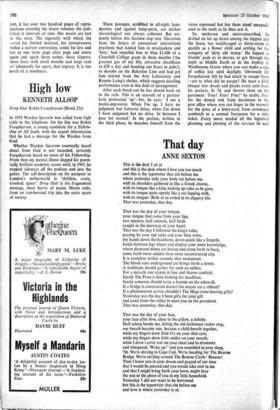Some think him ill-tempered & queer
SYLVIA TOWNSEND WARNER
The Kate Greenaway Treasury edited by Edward Ernest (Collins 42s) 'Illyrian woodlands, echoing falls Of water, sheets of summer glass, The long divine Penellan pass, The vast Akrokeraunian walls You shadow forth to distant men One may not immediately associate these lines with the Jumblies who went to sea in a sieve; but E. L., the travelling artist of Tennyson's dedication, was Edward Lear, artist of non- sense.
Painting was his livelihood. Before he was sixteen he was colouring prints for booksellers, 'making morbid disease drawings,' painting fans. His Illustrations of the Family of Psitta- cidae, or Parrots brought him a commission to paint the inmates of Lord Stanley's private menagerie at Knowsley. Grandee households of the 1830s affected tame cats, and Lear might well have remained at Knowsley, an odd young man with an enormous nose who was such good company and whose comic rhymes and drawings were so popular in the nurseries, if he had not become alarmed about his health, and restless. Lord Stanley sent him to Rome. Rome was full of artists and visiting patrors. Those who travelled, those who stayed at home, wanted pictures of foreign lands. Lear published seven illustrated travel books, seeking his material in the wilder, more picturesque, more verminous fringes of the Mediterranean.
His pattern'of life was established: in winter he travelled and made sketches; in summer he came back to England, finished his sketches, sold them, stayed with friends. He had many friends and they were kind. His talent was kind, too. He had a clever hand, a true eye, a delicate perception of contours and perspec- tives. More remarkable, he painted without a vestige of rant. And if, in his later years with the coming of photography and the drawing- room stereoscope, he lost his market, he kept his old friends, made new ones, and was recognised as a master of nonsense.
But concurrently with this pattern of a busy and fortunate life ran an undertow of appre- hension and blighted sexuality. He was an epileptic and homosexual. He endured the one laconically, going into hiding when he felt his attacks coming on, recording them, sometimes as many as twenty a month, with a little cross in his diary. The attacks of the other were more insidious, coming in the guise of friendship— ideal, total friendship; then smiting him down with the realisation that friendship was not what he wanted, that love was not what the other wanted. At intervals he peered at the expedient of marrying; but he was an epileptic.
'There was an old man in a fix, Who said, I can't possibly mix.'
It seems permissible to summarise Lear's tragic quandary like this. Though he did not invent the limerick, we think of it as his. It is typical, though, not personal. His personal self, his perforce acceptance of his tragic quandary, dictated the later Nonsense Songs and made them as mysteriously, indisputably poetical as the poems of Edgar Allan Poe; which they strangely resemble.
It is the signal merit of Vivien Noakes's bio- graphy that she conveys the continuity of Lear's discordant life without a single false emphasis. Her narrative is like his best drawings: clear, orderly, perceptive, detailed and without a vestige of rant. The scholarship of her re- searches is exemplary. So is the index.
Of the Books of Nonsense Ruskin wrote: 'Surely the most beneficent and innocent of all books yet produced.' Ruskin's approvals tend to be embarrassing to modern ears. There is a long run of them in The Kate Greenaway Treasury, and they are regrettably spontaneous; but his cavillings are shrewd. Sending back one of Kate Greenaway's sketches, he writes: 'Will you (it's all for your own good) make her stand up, and then draw her for me without her hat —and without her shoes—because of the heels, and without her mittens, and without her frock and frills? And let me see exactly how tall she is - and how round?'
The heels must have been exceptional: Kate Greenaway's Little Misses were flatsoled; but he was barking up the right tree otherwise. The hats and high sashes, the long frocks and the frills, make whatever extends between the pointed chins and slippered feet hypothetical. Limbs in movement are attached to the hypo- thesis in approximately the right places, bat nothing supports or directs them. It appears that Kate Greenaway was fond of dress- making, and made the frocks worn by her little models. If so, it is a pity she ever learned to thread a needle. With boys and with plebeian children her draughtmanship emerges. They are granted legs, they stand on their feet and are roundabout. But, at risk of sounding like Ruskin, I must admit that a picture of apples was the only thing in this enormous book which substantially pleased me.
The book is much too large to be fair to the artist. As well as numerous illustrations in the text, it has over two hundred pages of repro- ductions covering the dozen volumes she pub- lished at intervals of time. Her merits are lost in this mass. The ingenuity with which she varied her limited material, her inventiveness within a narrow convention, count for less and less as one turns page after page and meets again and again those sashes, those slippers, those faces with small mouths and large eyes set inhumanly far apart, that topiary. It is too much of a muchness.















































 Previous page
Previous page